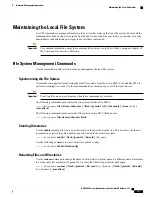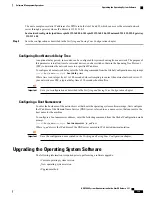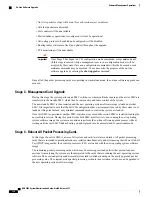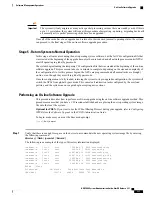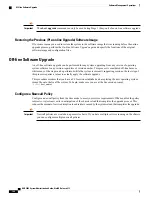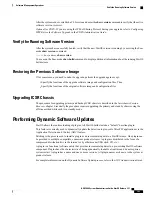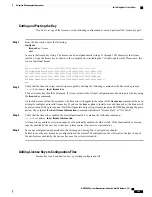
On-Line Software Upgrade
This method is used to perform a software upgrade of the entire operating system.
This method is not supported for the SGSN or for PDIF. Refer to the appropriate Administration Guide
for upgrade information.
Important
This method allows active sessions to be maintained until they are either self-terminated (subscriber ends
session) or meet the optionally defined upgrade limit values.
This method upgrades all standby packet processing cards simultaneously, then upgrades any active cards
simultaneously.
No new sessions will be accepted by the system during an on-line software upgrade. For PDSN and GGSN:
All new session requests are blocked from entering the system through the use of an overload policy. Failure
to configure this policy to redirect calls elsewhere can result in a significant service outage. For Closed R-P:
There is no explicit overload policy configuration for Closed R-P. The default overload behavior for Closed
R-P is to reject calls.
To minimize the risk of service outages, the on-line software upgrade should be performed during a planned
maintenance window.
Caution
An on-line software upgrade is performed in five stages, where each stage is limited to performing only
specific functions until the system is prepared to move to the next stage. Each stage is explained below.
System Requirements to Support the On-line Software Upgrade Method
A system requires a minimal amount of hardware to support this software upgrade method. The minimum
required application cards are:
•
Two SMCs (one Active and one Standby)
•
Two RCCs (required to support packet processing card migrations)
•
Three packet processing cards (one must be a standby, but two standby cards are recommended)
If your system does not meet this minimal system requirement, then this method of software upgrade cannot
be supported and you must use the
Off-line Software Upgrade, on page 140
method.
CLI Verification and System Preparation
After initiating the upgrade command, before beginning Stage 1 of the on-line software upgrade process the
system performs a series of checks and procedures. These include:
•
Verifying that an open boot priority is available in the boot stack.
•
Ensuring that the current local file system is synchronized.
•
Creating the new boot stack entry using the new operating system image, boot priority, and configuration
file information.
ASR 5000 System Administration Guide, StarOS Release 21.1
134
Software Management Operations
On-Line Software Upgrade
Summary of Contents for ASR 5000
Page 26: ...ASR 5000 System Administration Guide StarOS Release 21 1 xxvi Contents ...
Page 316: ...ASR 5000 System Administration Guide StarOS Release 21 1 288 VLANs VLAN Related CLI Commands ...
Page 400: ...ASR 5000 System Administration Guide StarOS Release 21 1 372 Engineering Rules ECMP Groups ...


